HTC One max Review - It's Huge
by Brian Klug on October 28, 2013 10:00 AM EST- Posted in
- Smartphones
- HTC
- Mobile
- One
- Snapdragon 600
- Android 4.3
- One max
Obviously the highlight of the One max is its huge 5.9-inch 1080p display. After all, the huge display is literally the reason for the max moniker and its gargantuan size. It’s still an IPS LCD, and like the One, resolution is 1920x1080. Using the same resolution at larger size means lower PPI, but the One max is still high enough (373.4 PPI) that individual pixels shouldn’t be visible at all.

One interesting thing to note about the One max however is that the android display density is still set to 480 PPI, putting it in the same DENSITY_XXHIGH category as the One. This means that applications will look like scaled copies of what you’d expect them to look like on the One. There’s an interesting ongoing debate about what users really expect from these larger-sized smartphones and the demographic that’s buying them. Do users want scaled, larger applications which are easier to read, or the ability to display more content. HTC oddly enough seems to have scaled parts of their own UI, for example the widget panels are five row instead of four on the One max, and the launcher defaults to the 4x5 size instead of 3x4 which would look downright silly, further the status bar is also smaller.

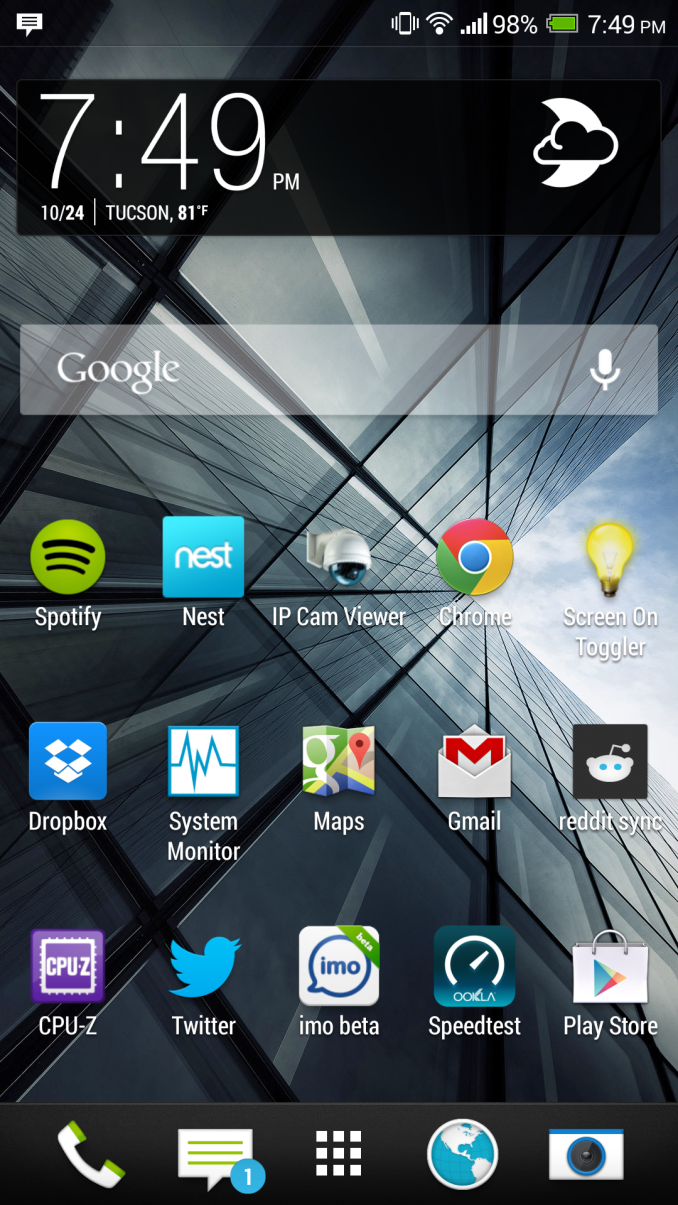
HTC One (Left), HTC One max (Right) – Note the grid and icon size changes
I’m not complaining, it’s just interesting to see 480 in Android but the HTC apps scaled down to give more real-estate, which is what I’d prefer since I have good vision.
One improvement I’m really happy about in Sense 5.5 is a change to the auto brightness function. Rather than just have a checkbox, the One max will allow you to set an upper bound for the auto brightness algorithm. Ideally I would like a higher or upper bound, or a bias function (+/- some delta), but this is a step in the right direction.
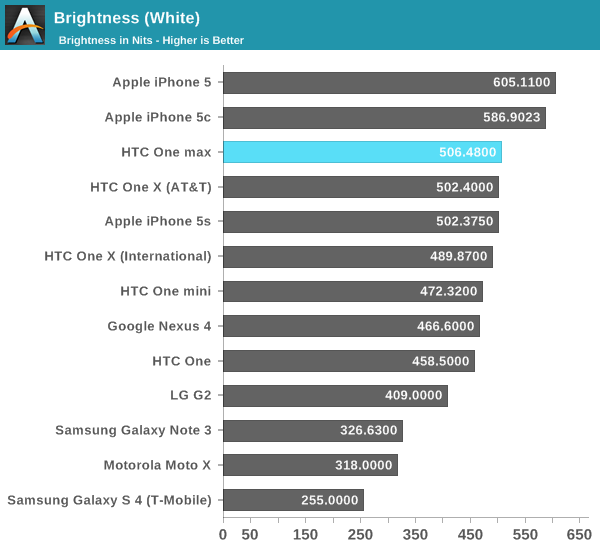
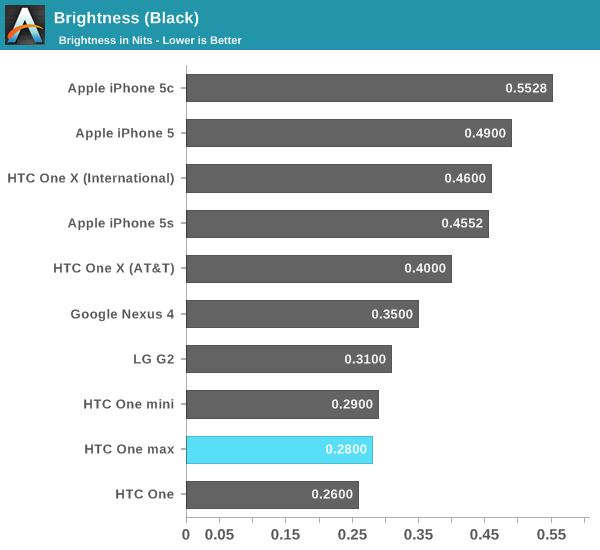
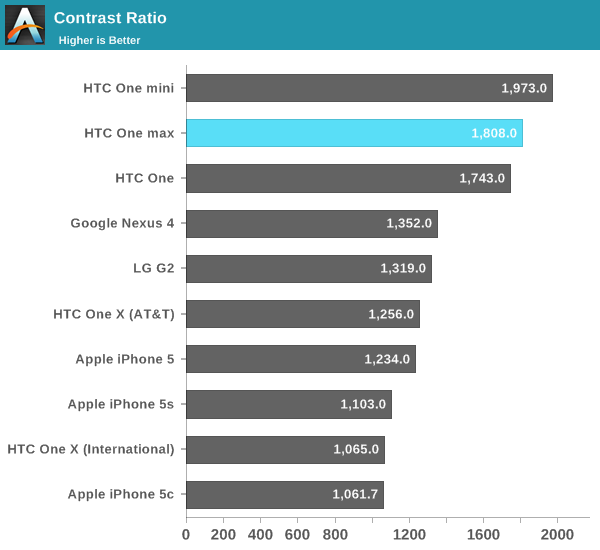
The One max display goes very bright, up to 506 nits, higher than the One or One mini. White point is also a bit more controlled than the One, at 7301 K average. My biggest complaint about the One max is that like the One it has a dynamic brightness/contrast function that adjusts screen brightness as a function of the content being displayed. That alone isn’t a huge problem, it’s just that there’s no way to disable it in the UI, which would be great, since it’s distracting watching screen brightness change as you move around the UI. I would love to see HTC go the Google approach and restrict these functions to full screen video playback, and give the option to turn it off entirely.

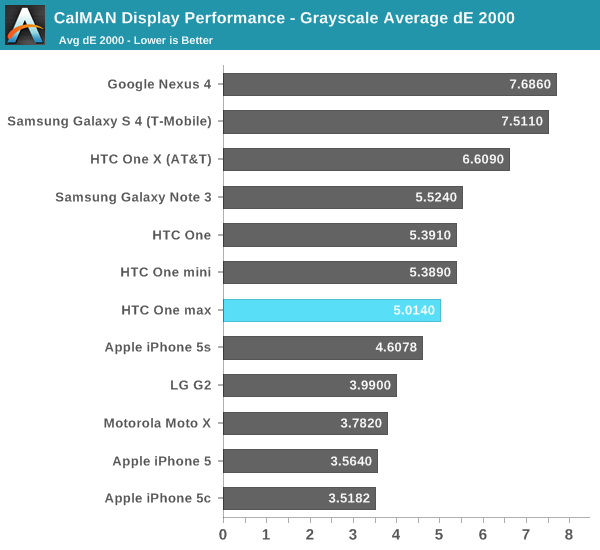
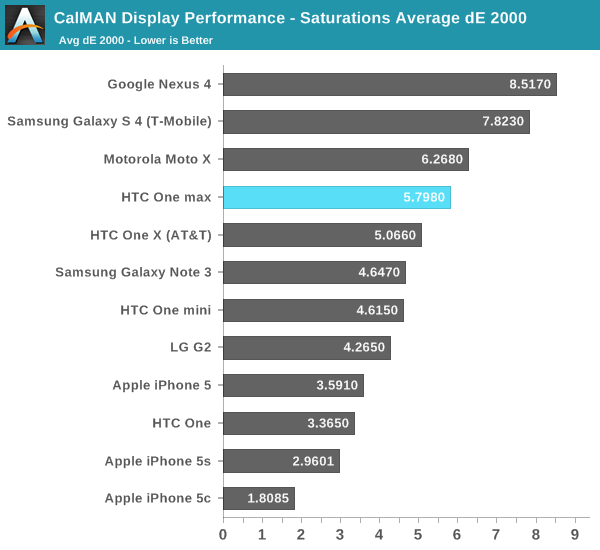


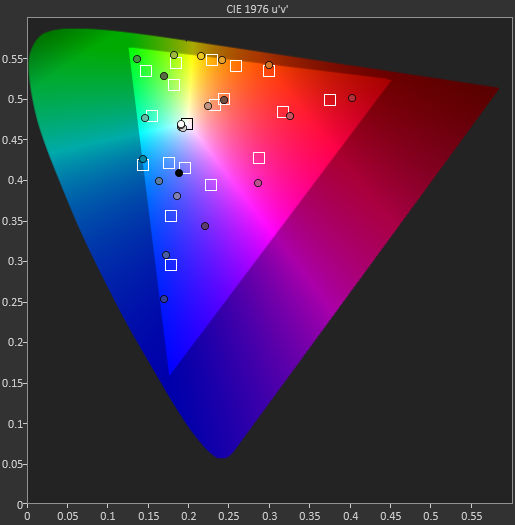
Running it through our display tests, it’s clear that the One max also has a bit of the saturation boost we’ve seen popping up on other phones as well. The saturation curves are great until the second to last point, which is almost set to maximum saturation. I’d love to see even more emphasis on color accuracy for the next generation of phones, the One max seems to be in the general ballpark of the One, but slightly worse.


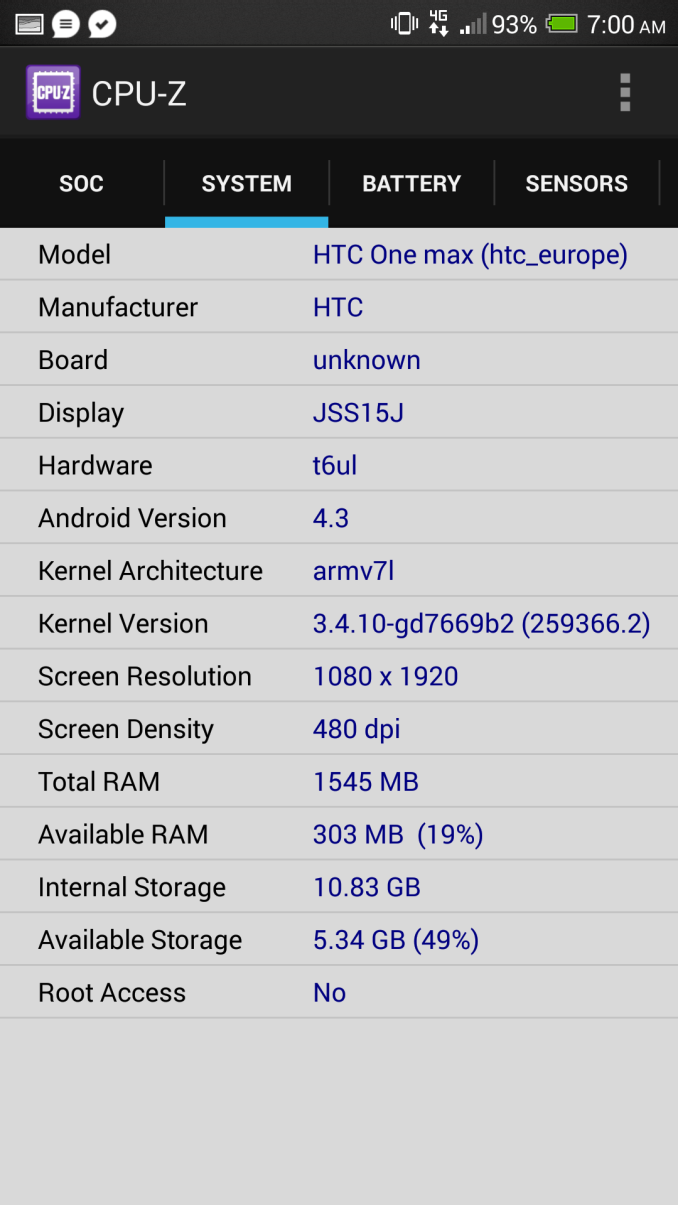
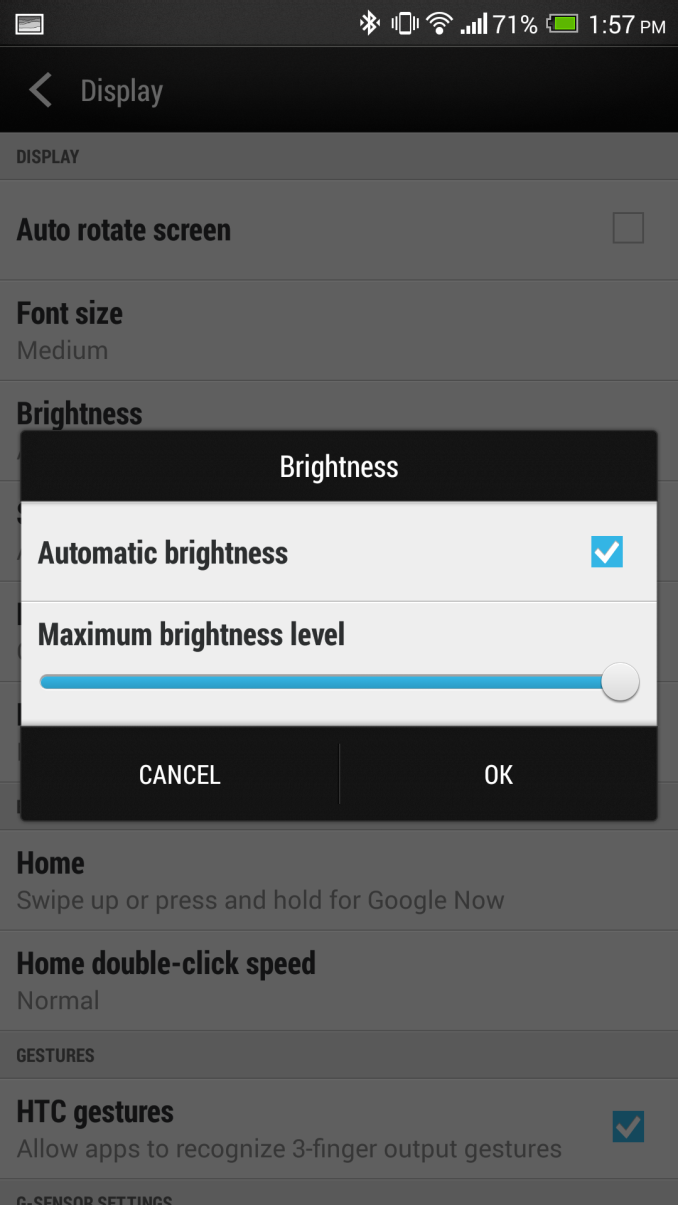









197 Comments
View All Comments
Steven JW FCK - Monday, October 28, 2013 - link
How can you say a "very tiny part of the market" and know for certain? I know so many Samsung smartphone users, and do you want to know how many of them have been asked by Samsung how they use there micro SD cards, and the data storage facilities on their phones?NONE OF THEM!
So where on earth are you pretending to get your data from? And how exactly are you interpreting the numbers? I just fail to believe you actually know the ins and outs of phone storage and micro SD card usage in smartphones upon a broad enough scale to start making allegations like you have.
Believe the reality you want, it only exists in a very small and exceptionally annoying minority.
rabidkevin - Tuesday, October 29, 2013 - link
Bullshitsuperflex - Tuesday, October 29, 2013 - link
Agreed.Someone need to grease their gears. Their screech is annoying and not supported by a vast majority.
lazymangaka - Monday, October 28, 2013 - link
I don't understand the the reviewer's hatred of MicroSD cards. They're a useful thing to have, for every type of user. And, the fact of the matter is, internal storage space has not been rapidly increasing in smartphones. Storage needs have, however. Unlimited data plans are gone for many users, so listening to locally-stored music makes much more sense. In addition to that, the megapixel count of smartphone cameras continue to march north, and those larger file sizes are competing with ever-increasing app sizes. MicroSD expansion just makes sense.I understand what Google was trying to do in nixing external expansion in its Nexus lineup, but it just hasn't played out the way they wanted it to. Instead of getting a phone with 16GB of internal storage and an external expansion slot, we're more likely to just get a phone with 16GB of internal storage. Campaigning for the continued removal of MicroSD storage is doing nothing but harming us all.
Mondozai - Monday, October 28, 2013 - link
Lazumangaka:"I don't understand the the reviewer's hatred of MicroSD cards."
Every reviewer have their irrational foibles that makes no sense. You just have to learn those blindspots and avoid them like the plague with each particular reviewer.
With Brian we know he hates WP8, he dislikes microSD cards and he winces on AMOLED screens. He still puts out very qualified reviews but again, know when to listen, and when to just skip.
Brian Klug - Monday, October 28, 2013 - link
Luckily it's easy to back up the dislikes of microSD (poor Android support, slower than native storage, tradeoffs in build quality) and AMOLED screens (oversaturated, higher power drain, burn in, and sensitive to overheating), and reasons why I can't get anything done on WP8. They aren't blind spots that make no sense, they're just realities.-Brian
PC Perv - Tuesday, October 29, 2013 - link
What an arrogant hoax. You surely realize that every point you raise has counter points, right?How about being on consumer side for once? Make a case why 32 GB should be the bottom line. And why 64 GB should cost $20 more, not $100 more, etc,. Stop worrying about OEMs. They are doing fine. Think for once from consumers standpoint, instead of corporate-hired marketeering.
rabidkevin - Tuesday, October 29, 2013 - link
Hello apple paid spokepersonsuperflex - Tuesday, October 29, 2013 - link
Hello Samsung ShillDentons - Tuesday, October 29, 2013 - link
You're displaying confirmation bias, writ large.We can all find window dressing to support our opinions. That's why so many here object to your rants on AMOLED, microSD, and batteries. Despite your technical expertise, we realize your opinions in those areas has little basis in truth, and is largely just an smug opinion.
Yes, the NAND on many microSD cards is inferior to NAND built into devices. We know and we Don't Care! We use it to hold mass media, videos, photos, and music. What we care about far more is that microSD is often 10 times more cost effective and functions very well indeed.
Really Brian, telling users they really don't need the features they use and love is the height of contemptuous arrogance.